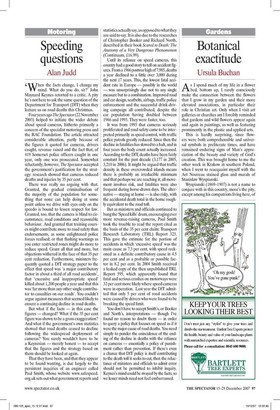Speeding questions
Alan Judd G When the facts change, I change my mind. What do you do, sir?' John Maynard Keynes retorted to a critic. A pity he's not here to ask the same question of the Department for Transport (DfT) when they lecture us on road deaths this Christmas.
Four years ago The Spectator (22 November 2003) helped to initiate the wider debate about speed cameras, hitherto primarily a concern of the specialist motoring press and the RAC Foundation. The article attracted considerable attention, partly because of the figures it quoted for cameras, drivers caught, revenue raised and the fact that, of 419 Somerset police officers caught in one year, only one was prosecuted. Somewhat reluctantly, however, The Spectator accepted the government's justification for the strategy: research showed that cameras reduced deaths and injuries by 35 per cent.
There was really no arguing with that. Granted, the gradual criminalisation of the majority of the population for something that none can help doing at some point unless we drive with eyes only on the speedo is bound to lessen respect for law. Granted, too, that the camera is blind to circumstance, road conditions and reasonable behaviour. And granted that training courses might contribute more to road safety than endorsements, as some enlightened police forces realised; or that flashing warnings as you enter restricted zones might do more to reduce speed. Grant all that and more, but objections withered in the face of that 35 per cent reduction. Furthermore, ministers frequently quoted a DfT strategy paper to the effect that speed was 'a major contributory factor in about a third of all road accidents', that 'excessive and inappropriate speed' killed about 1,200 people a year and that this was `far more than any other single contributor to casualties on our roads'. You couldn't argue against measures that seemed likely to ensure a continuing decline in road deaths.
But what if the facts — in this case the figures — changed? What if the 35 per cent figure was shown to be a gross exaggeration? And what if the government's own statistics showed that road deaths ceased to decline following the widespread deployment of cameras? You surely wouldn't have to be a Keynesian — merely honest — to accept that the figures and the strategy based on them should be looked at again.
That they have been, and that they appear to be found wanting, is due largely to the persistent inquiries of an engineer called Paul Smith, whose website www.safespeed. org.uk sets out what government reports and statistics actually say, as opposed to what they are said to say. It is also due to the researches of Christopher Booker and Richard North, described in their book Scared to Death: The Anatomy of a Vety Dangerous Phenomenon (Continuum, £16.99).
Until its reliance on speed cameras, this country had a good story to tell on accident figures. From a 1966 postwar high of 7,985, deaths a year declined to a little over 3,000 during the next 17 years. This, the lowest fatal accident rate in Europe — possibly in the world — was unsurprisingly due not to any single measure but to a combination. Improved road and car design, seatbelts, airbags, traffic police enforcement and the successful drink-driving campaign all contributed, despite the car population having doubled between 1966 and 1993. They were faster, too.
It was from 1993 that cameras seriously proliferated and road safety came to be interpreted primarily as speed control, with traffic police patrols greatly reduced. Since then the decline in fatalities has slowed to a halt, and in four years the body count actually increased. According to the DfT, deaths have been fairly constant for the past decade (3,177 in 2005, 3,210 in 2006). It might be argued that traffic density in these overcrowded islands means there is probably an irreducible minimum and that perhaps we are reaching it; all movement involves risk, and fatalities were also frequent during horse-drawn days. The alternative — staying at home — is also risky, with the accidental death total in the home roughly equivalent to the road toll.
But as ministers and officials continued to bang the 'Speed kills' drum, encouraging ever more revenue-raising cameras, Paul Smith took the trouble to read the report cited as the basis of the 35 per cent claim: Transport Research Laboratory (TRL) Report 323. This gave the estimate for the portion of accidents in which 'excessive speed' was the main cause as 7.3 per cent, with speed reckoned as a definite contributory cause in 4.5 per cent and as a probable or possible factor in 8.2 per cent. In 2004 Smith received a leaked copy of the then unpublished TRL Report 595, which apparently found that fatal and serious crashes on motorways were 32 per cent more likely where speed cameras were in operation. Last year the DfT admitted that only 5 per cent of road accidents were caused by drivers who were found to be breaking the speed limit.
You don't have to accept Smith's, or Booker and North's, interpretations — though I've found no reason to doubt them — in order to query a policy that focuses on speed as if it were the major cause of road deaths. You need simply to ponder the coincidence of the ending of the decline in deaths with the reliance on cameras — essentially a policy of punishment rather than prevention. If there's even a chance that DIT policy is itself contributing to the death toll it seeks to cut, then the reluctance of ministers and officials to admit error should not be permitted to inhibit inquiry. Keynes's mind could be swayed by the facts, so we lesser minds need not feel embarrassed.

































































































 Previous page
Previous page